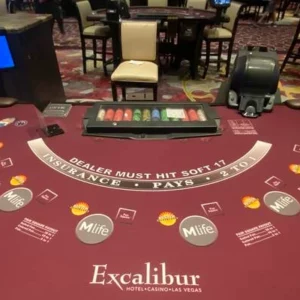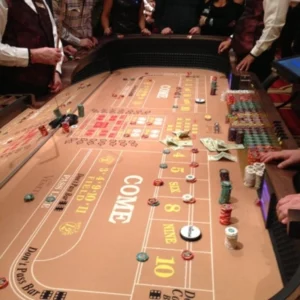Free Table Games Lessons

Learn how to play casino table games before you place your bets!
Various Las Vegas casinos offer free gambling lessons for table games. These lessons are designed to help beginners learn the basic rules, strategies, and etiquette unique to each game. You can attend free classes for games such as blackjack, craps, roulette, poker, and more.
Below are the Las Vegas casinos that currently offer free gambling lessons. No reservation is required, just show up!
Circus Circus Hotel & Casino
Free Gambling Lessons:
- Monday – Friday. Blackjack 10:30 am, Roulette 11:30 am, Craps 12:30 am
- Call (702) 734-0410 for more details.

Excalibur Hotel & Casino
Free Learn to Gamble Lessons:
- Monday – Friday, Roulette 11:00 am, Blackjack 11:30 am, Craps 12:00 pm
- Call (702) 597-7777 for additional information.

Gold Coast Hotel & Casino
Free Table Games Lessons:
- Craps: Friday – Sunday, 11:30 am
- Call (702) 597-7777 for more information.

Golden Nugget Hotel & Casino
Free Table Games Instruction:
- Three Card Poker, Crazy 4 Poker, Let it Ride, Pai Gow Poker, Ultimate Texas Hold’Em, and Mississippi Stud Poker: Daily 10 am
- Roulette: Daily, 11:30 am | Blackjack: Daily at noon
- Craps: Mon-Wed, 10 am; Thu-Sun, 10 am and 12 pm
- For more information, call (702) 385-7111

Luxor Hotel & Casino
Free Gaming Lessons Offered Daily:
- See the pit or call (702) 262-4000 for details.

Sahara Hotel & Casino
Free Daily Craps Lessons:
- 12:30 pm in the Table Game area in front of the CASBAR Lounge.
- Call (702) 761-7000 for more details.

Venetian Resort & Casino
Complimentary Gaming Lessons:
Craps lessons are available Monday-Friday at 11:00 am. Visit The Venetian craps pit across from the main cage to join.
- Call (866) 659-9643 for more information.

Learn How to play now
HOW TO PLAY BLACKJACK
Blackjack, or 21, is one of the most popular card games played in our casino. It is easy to learn and exciting to play. Casinos may offer one, two, six, and eight-deck games. One and two-deck games may be “hand-dealt,” while more than two decks will be dealt from a box called a “shoe.”
In blackjack, everyone plays against the dealer. In the hand-dealt game, the players are dealt two cards face down. In the shoe-dealt version, players receive both cards face up. In both versions, the dealer gets their first card face up and the second card face down. The object of the game is to get as close as possible to 21 without going over 21. If a hand goes over 21, it is called a “bust” or “break,” and the wager is lost. In 21, Jacks, Queens, Kings, and 10s count as 10. An Ace may be played as a one or an 11. All other cards are played at face value.
When you receive your first two cards, you may either “stand” or “hit.” When you “stand,” it means you feel you are close enough to 21 and no longer wish for any additional cards. If you want to receive another card or “hit,” scratch the surface of the table with your first two cards (hand-dealt games only). If you wish to “stand,” tuck your cards underneath your bet.
In the shoe-dealt version, you don’t need to touch your cards. You will indicate a “hit” or “stand” by using hand signals. In both methods of play, you may draw as many cards as you want until you are close to 21 or until you “bust” or “break.”
If you are closer to 21 than the dealer, you win and are paid an amount equal to your original wager. If your hand is less than the dealer’s, you lose. If the dealer’s hand “busts” or “breaks,” you win as well. Ties are a standoff or “push,” and your bet remains on the table.
If your initial two cards total 21, any Ace with a 10, Jack, Queen, or King, you have a blackjack. Blackjack is paid either 6 to 5 or 3 to 2, depending on the type of blackjack you are playing.
In 21, the player has many options to choose from:
SPLITTING PAIRS
If your first two cards have the same numerical value, you may split them into two hands. The second hand’s bet must be equal to the original bet. If the split pair is Aces, you are limited to a one-card draw on each hand. (Note: Re-splitting Aces is not available on the Double Deck game.)
DOUBLING DOWN
After receiving your first two cards, you may elect to wager an additional amount not to exceed the value of the original bet. With a double down, you will be dealt one additional card only.
INSURANCE
If the dealer’s face-up card is an Ace, you may elect to take insurance. The insurance bet is a wager that the dealer has a blackjack. You may bet up to one-half of your original bet. Insurance bets pay 2 to 1 if the dealer has blackjack but loses in all other instances.
SURRENDER
An uncommon but popular player option offered by some casinos is surrender. Players have the option of surrendering one-half of their original wager after receiving their first two cards. If you surrender your cards, the dealer will take half of your wager.
BLACKJACK VARIATIONS:
Some casinos offer variations of Blackjack, such as:
FREE BET BLACKJACK
Free Bet Blackjack is a blackjack game where, under certain situations, the guest has the option of splitting or doubling down with the house, providing a Free Bet Token for the additional wager.
SPANISH 21
Spanish 21 is an exciting blackjack variation where all 10s have been removed from the decks. Players win on all blackjacks and may double on any hand total after hitting a split hand.
HOW TO PLAY CRAPS
Craps is a thrilling, fast-paced game played with a pair of dice. Here are the basic terms and betting rules to get you started:
- Shooter: The player who throws the dice. All bets must be placed before the dice are thrown.
Types of Wagers:
- THE PASS LINE: An even-money bet placed on the first roll (the “come out roll”). You win if a 7 or 11 rolls and lose if 2, 3, or 12 (known as “craps”) rolls. Any other number becomes the “point,” and the point must roll again before a 7 to win.
- THE DON’T PASS: An even-money bet, opposite of the pass line. You lose on the comeout roll if the shooter rolls a 7 or 11. You win on a 2 or 3 (12 is a tie). Once a point is established, you win if a 7 rolls and lose if the point rolls.
- COME BETS: Placed after the come-out roll when the shooter has a point. You win on a 7 or 11 and lose on a 2, 3, or 12. Any other number becomes your “come bet” and must roll again before a 7 to win.
- DON’T COME BETS: Opposite of come bets, placed after the come-out roll when the shooter has a point. You win on a 2 or 3 (12 is a tie) and lose on a 7 or 11. Any other number becomes your “don’t come bet” and must not roll again before a 7 to win.
- ODDS: Once a point or come bet is established, you can take the odds and win if the point or come bet hits before a 7. Payoffs are 2:1 on 4 and 10, 3:2 on 5 and 9, and 6:5 on 6 and 8. For don’t pass or don’t come bets, you must lay the odds to win.
- PLACE BETS: Once a shooter makes a point, you can place a bet on 4, 5, 6, 8, 9, or 10. If these numbers roll before a 7, you win. Payoffs are 9:5 on 4 and 10, 7:5 on 5 and 9, and 7:6 on 6 and 8. You can remove a place bet anytime before the next roll.
- FIELD BETS: A one-roll bet. You win even money on 3, 4, 9, 10, and 11; 2:1 on 2; and 3:1 on 12. You lose on 5, 6, 7, or 8.
- PROPOSITION BETS (PROPS): One-roll bets in the center of the table. You win if the next roll is any of the following:
– Any Craps (2, 3, or 12) pays 8:1
– Aces (2) or Twelve (12) pays 31:1
– Ace-deuce (3) or Eleven (11) pays 16:1
– Seven (7) pays 5:1
- HARDWAYS: Bets on pairs (e.g., 4-4 for hard 8). You win if the pair rolls before a seven or the number rolls the “easy way.” Payoffs are:
– Hard Four or Ten pays 8:1
– Hard Six or Eight pays 10:1
- HOP BETS: One-roll bets on specific combinations. For example, betting on a 6-3 combination. Payouts are 31:1 or 16:1, depending on the combination.
CRAPLESS CRAPS
A variant of craps without “craps” numbers. On the come-out roll, you win with a 7, and any other number becomes the point. To win, the point must roll again before a 7.
DICE-OLOGY
This side wager allows three optional bets: Little Ones (2, 3, 4, 5, 6), Big Ones (8, 9, 10, 11, 12), and Boom or Bust (2, 3, 4, 5, 6, 8, 9, 10, 11, 12). You win if you complete a grouping of numbers before a 7 rolls.
HOW TO PLAY ROULETTE
Roulette is an intriguing game that is played throughout the world. The prospect of large payoffs from small wagers attracts both expert and novice players alike. To keep bets distinct, each player uses differently colored chips, with their value determined by the purchase price. Make sure to redeem your chips at the same table where you played, as their value won’t be recognized elsewhere.
Each spin of the roulette wheel offers numerous betting options. Players can wager on single numbers, rows, adjacent numbers, colors, or whether numbers are odd or even. A bet on a single number pays 35 to 1, including 0 and 00. Bets on red or black, or odd or even numbers, pay even money (1 to 1).
Casinos offer three variations of roulette, each with a different number of zeros on the wheel (1, 2, or 3), which affects the “house percentage.”
1. American Roulette: This version features 36 numbered slots, along with 0 and 00, resulting in a house edge of 5.26%.
2. European Roulette: This version features 36 numbers and a single 0, making it popular among knowledgable players, with a house edge of 2.70%.
3. Triple-Zero Roulette: This version features 36 numbers, as well as 0, 00, and 000, resulting in a high house edge of 7.69%.
The following shows the payoffs for single-chip bets and the available combinations. The dealer will gladly explain any of them. The precise placement of chips determines the bet, and each player is responsible for correctly positioning their wager on the layout, even if the dealer places the bet.
BETTING OPTIONS AND PAYOFFS:
- Single number bet (“straight up”) – Pays 35 to 1.
- Double number bet (“split”) – Pays 17 to 1.
- Three number bet (“street”) – Pays 11 to 1.
- Four number bet (“corner bet”) – Pays 8 to 1.
- Five number bet – Pays 6 to 1. Specific bet on 0-00-1-2-3.
- Six number bet (“line”) – Pays 5 to 1. Example: 7, 8, 9, 10, 11, 12.
- 12 numbers or dozens (first, second, third dozen) – Pays 2 to 1.
- Column bet (12 numbers in a row) – Pays 2 to 1.
- 18 numbers (1-18) – Pays even money.
- 18 numbers (19-36) – Pays even money.
- Red or black – Pays even money.
- Odd or even – Pays even money.
HOW TO PLAY BACCARAT
Baccarat is a popular card game found in casinos around the world, known for its simplicity and elegance. The game is usually played with eight decks of cards and involves two hands: the Player and the Banker. Here’s a step-by-step guide on how to play baccarat:
Objective
- The goal of baccarat is to bet on the hand that you think will have a total value closest to 9. You can bet on the Player’s hand, the Banker’s hand, or a Tie.
Card Values
- Aces are worth 1 point.
- 2 to 9 are worth their face value.
- 10, Jack, Queen, and King are worth 0 points.
Game Setup
- Placing Bets: Players place their bets on either the Player, Banker, or Tie.
- Dealing Cards: Two cards are dealt face up to both the Player and the Banker hands.
Calculating the Hand Value
- Add the values of the two cards in each hand.
- If the total is 10 or more, subtract 10. This means the hand value is always between 0 and 9.
- For example, a hand with 7 and 5 totals 12. Subtracting 10 gives a value of 2.
Natural Win
- If the Player or Banker has a total of 8 or 9 with the first two cards, it’s called a “natural” and no more cards are drawn. The hand with the natural win is the winner.
Drawing a Third Card
- If neither hand has a natural, the drawing rules determine if a third card is drawn.
- Player’s Third Card Rules:
– If the Player’s total is 0-5, the Player draws a third card.
– If the Player’s total is 6-7, the Player stands (does not draw a card).
- Banker’s Third Card Rules:
– If the Player stands (i.e., has a total of 6-7), the Banker follows the same rules as the Player.
– If the Player draws a third card, the Banker draws or stands based on the following conditions:
– Banker’s total is 0-2: Banker draws a third card.
– Banker’s total is 3: Banker draws if the Player’s third card is not 8.
– Banker’s total is 4: Banker draws if the Player’s third card is 2-7.
– Banker’s total is 5: Banker draws if the Player’s third card is 4-7.
– Banker’s total is 6: Banker draws if the Player’s third card is 6-7.
– Banker’s total is 7: Banker stands.
Winning
– The hand closest to 9 wins.
– If you bet on the winning hand, you win.
– Player Bet: Pays 1 to 1.
– Banker Bet: Pays 1 to 1, minus a 5% commission to the house.
– Tie Bet: Pays 8 to 1 or 9 to 1, depending on the casino.
Example of a Round
1. Place Bets: Bet on Player, Banker, or Tie.
2. Deal Cards: Player and Banker each receive two cards.
3. Calculate Totals: Determine if either hand has a natural.
4. Draw Third Card: Follow the drawing rules if necessary.
5. Determine Winner: The hand closest to 9 wins.